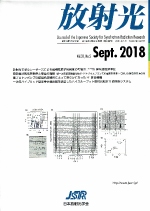

| 日本放射光学会誌 Journal of JSSRR |
 |
 |
| Vol.31,No.5/Sept. 2018 |
|
|
 |
| 【表紙の説明】 β-Sr0.33V2O5 は圧力温度(P-T) 相図上で,金属的な2つの電荷無秩序相CDO1 (n = 1), CDO2 (n = ∞),絶縁体的な2 つの電荷秩序相CO1 (n = 3), CO2(n = 5), 計4 つの比較的robust な相が1 GPa, 100 K付近の1 点で交わって4 重臨界点を形成している。この4重臨界点近傍で,非自明な高次高調波相n = 7, 11相が温度関数として,多少共存しながらstep wise に出現する。CDO2 で出現する-5 0 4 ピークは長波長極限(n → ∞) と解釈できる。また,この観測ではn = 9相が欠落し,電荷変調波が素数倍波長選択的であるように見える。 The higher-order (HO) phases of β-Sr0.33V2O5 that emerge at the vicinity of tetra-critical point. The XRD peaks from the HO phases appear between k = ±1/5 and k = 0 = 1/∞ positions. (a)Wide range (0 < P < 2 GPa, 0 < T < 300 K) pressure-temperature (P-T) phase diagram of this compound. One can see the relatively robust four kinds of phases, conductive CDO1 (n = 1) and CDO2 (n = ∞) phases, and insulative CO1 (n = 3) and CO2 (n = 5) phases, meet at one P-T point around 1 GPa and 100 K in this diagram. (b) The typical XRD images in these four phases. The bold dotted lines show the k-axis. (c) The temperature evolution (1 K increment) of the XRD intensity profiles along the k-axis obtained from the XRD images that taken at 0.9 GPa. (d) Its macro-graph at around the -5 0 4 position, in which one can see the several kinds of the HO phases and their coexistence. (e) The temperature dependence of k-position of the highest peak of these XRD intensity profiles. Note that -5 0 4 (-5 1/∞ 4) peak is extinction reection in CDO1 phase and it appears in CDO2 phase. This means that CDO2 phase can be interpreted as long-wave-length limit of nb modulations. In this measurement, n = 9 phase seemed to be absent. Thus, we could expect the prime-number selective nature of the charge modulation in this compound. |
| ・ |  |
| *放射光によるコミュニケーション 中井 泉(p.303)(2ページ、837k) |
|
| ・ |  |
| *放射光で探るレーザー光による超精密原子核制御の可能性:229Th 極低核励起準位 吉見彰洋、笠松良崇、北尾真司、瀬戸 誠、増田孝彦、山口敦史、依田芳卓、吉村浩司(p.305) *Exploring the possibility of ultra-precise nuclear clock by using synchrotron radiation: Extraordinary low-lying nuclear level of 229Th Akihiro YOSHIMI, Yoshitaka KASAMATSU, Shinji KITAO, Makoto SETO, Takahiko MASUDA, Atsushi YAMAGUCHI, Yoshitaka YODA and Koji YOSHIMURA (10 pages, 4,087k) |
|
| *奇数選択的電荷秩序と悪魔の階段 擬一次元伝導性酸化物β-バナジウムブロンズの電荷自由度上に咲いた新奇な悪魔の花 山内 徹、植田浩明、大和田謙二、中尾裕則、上田 寛(p.315) *Odd numbers selective charge ordered phases and devils's staircase ―A devil's flower of new species, blooming on a charge degree of freedom in quasi-one dimensional vanadium oxide conductors, di-valent β-vanadium bronzes― Touru YAMAUCHI, Hiroaki UEDA, Kenji OHWADA, Hironori NAKAO and Yutaka UEDA (10 pages, 6,212k) |
|
| *胃プロトンポンプの結晶構造解析によって明らかになったH+排出機構 阿部一啓(p.325) *The H+ extrusion mechanism revealed by crystal structures of the gastric proton pump Kazuhiro ABE (8 pages, 6,341k) |
|
| ・ |  |
| 一次元ハイブリッド型半導体検出器を搭載したハイスループット放射光粉末X線回折システム 河口彰吾、杉本邦久(p.333) *High-throughput synchrotron powder diffraction measurement system with multiple one-dimensional MYTHEN detectors Shogo KAWAGUCHI and Kunihisa SUGIMOTO (6 pages, 3,875k) |
|
| ・ |  |
| *次世代放射光施設の推進に関する状況について(4)―量子科学技術研究開発機構と光科学イノベーションセンター間の連携協力協定の締結― 内海 渉(p.339) (2 pages, 994k) |
|
| ・ |
| Back |